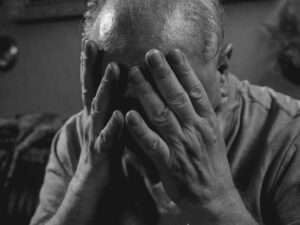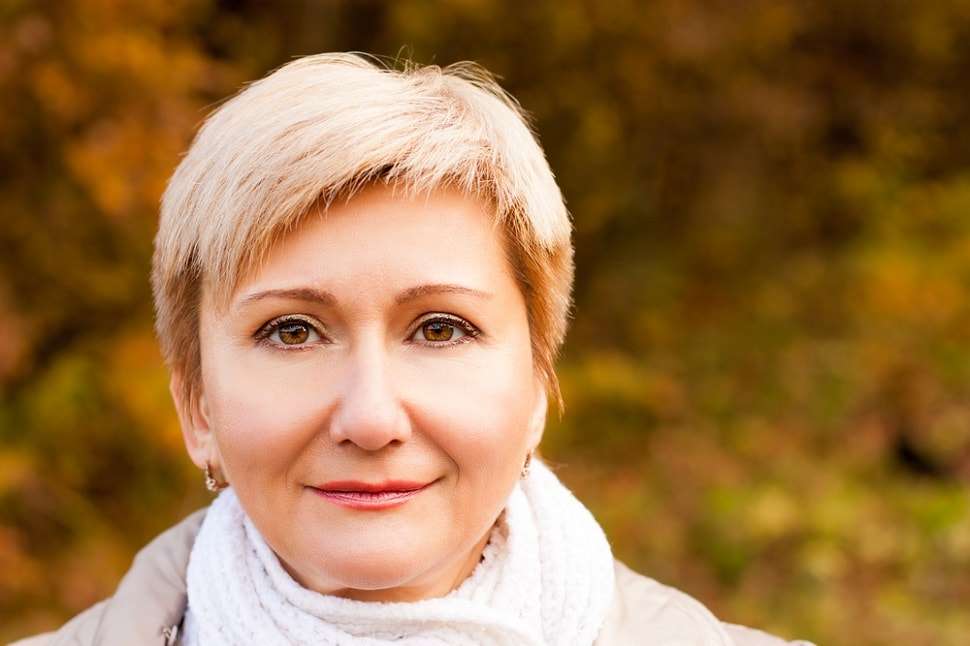While most but not all traumatized people experience short term symptoms, the majority do not develop ongoing (chronic) PTSD. Not everyone with PTSD has been through a dangerous event. Some experiences, like the sudden, unexpected death of a loved one, can also cause PTSD. Symptoms usually begin early, within 3 months of the traumatic incident, but sometimes they begin years afterward. Symptoms must last more than a month and be severe enough to interfere with relationships or work to be considered PTSD. The course of the illness varies. Some people recover within 6 months, while others have symptoms that last much longer. In some people, the condition becomes chronic.
A doctor who has experience helping people with mental illnesses, such as a psychiatrist or psychologist, can diagnose PTSD.
To be diagnosed with PTSD, an adult must have all of the following for at least 1 month:
- At least one re-experiencing symptom
- At least one avoidance symptom
- At least two arousal and reactivity symptoms
- At least two cognition and mood symptoms
Re-experiencing symptoms include:
- Flashbacks—reliving the trauma over and over, including physical symptoms like a racing heart or sweating
- Bad dreams
- Frightening thoughts
Re-experiencing symptoms may cause problems in a person’s everyday routine. The symptoms can start from the person’s own thoughts and feelings. Words, objects, or situations that are reminders of the event can also trigger re-experiencing symptoms.
Avoidance symptoms include:
- Staying away from places, events, or objects that are reminders of the traumatic experience
- Avoiding thoughts or feelings related to the traumatic event
Things that remind a person of the traumatic event can trigger avoidance symptoms. These symptoms may cause a person to change his or her personal routine. For example, after a bad car accident, a person who usually drives may avoid driving or riding in a car.
Arousal and reactivity symptoms include:
- Being easily startled
- Feeling tense or “on edge”
- Having difficulty sleeping
- Having angry outbursts
Arousal symptoms are usually constant, instead of being triggered by things that remind one of the traumatic events. These symptoms can make the person feel stressed and angry. They may make it hard to do daily tasks, such as sleeping, eating, or concentrating.
Cognition and mood symptoms include:
- Trouble remembering key features of the traumatic event
- Negative thoughts about oneself or the world
- Distorted feelings like guilt or blame
- Loss of interest in enjoyable activities
Cognition and mood symptoms can begin or worsen after the traumatic event, but are not due to injury or substance use. These symptoms can make the person feel alienated or detached from friends or family members.
It is natural to have some of these symptoms for a few weeks after a dangerous event. When the symptoms last more than a month, seriously affect one’s ability to function, and are not due to substance use, medical illness, or anything except the event itself, they might be PTSD. Some people with PTSD don’t show any symptoms for weeks or months. PTSD is often accompanied by depression, substance abuse, or one or more of the other anxiety disorders.
Do children react differently than adults?
Children and teens can have extreme reactions to trauma, but some of their symptoms may not be the same as adults. Symptoms sometimes seen in very young children (less than 6 years old), these symptoms can include:
- Wetting the bed after having learned to use the toilet
- Forgetting how to or being unable to talk
- Acting out the scary event during playtime
- Being unusually clingy with a parent or other adult
Older children and teens are more likely to show symptoms similar to those seen in adults. They may also develop disruptive, disrespectful, or destructive behaviors. Older children and teens may feel guilty for not preventing injury or deaths. They may also have thoughts of revenge.
This is a very difficult question toanswer, because everyone is different, everyone’s story is different, andeveryone’s trauma is “stuck” in a unique way.
But clients have a right to know howlong things might take. So to show I’m not avoiding the question altogether, I’lltalk about it a little bit.
First of all, many people have spent many years suffering. It’s natural to want a quick fix, and our society specializes in quick. Unfortunately, it’s more difficult to do that with therapy than with other things. That said, trauma therapy used to take many years, and with more modern and powerful therapies, it usually doesn’t. Trauma therapy length depends on a number of factors, so let’s start there.
What influences how long it takes?
What are the factors?
There are many factors that go intodetermining this; before our first session, I don’t know any of them, and someof them we’ll never know, or at least not until afterwards. The good news is that there is an afterwards. Some things that influence how long it takesto get there:
Your goals
Some people want a deep healing of their symptoms, others are satisfied with some significant changes that help them in their everyday life; sometimes people just want to be well enough to function in a job or a relationship. This part depends on you.
The type and severity of the trauma
If we’re just working on a single event that happened when you were an adult, then it could be fairly short—possibly between 1-3 months. The research on childhood trauma recommends 15-30 months, but I’ve had clients who were satisfied with what they accomplished sooner, sometimes much sooner. But no matter what, we can’t know how it will go until we get started.
How “stuck” is the trauma?
If you’ve read my pages on PTSD, you know that the symptoms we see are natural and reasonable responses to threat. However, the threat is now over. (If it’s not over, trauma therapy might not be exactly the right thing, or it might not work so well.) So the body seems stuck in a place where it responds as if the trauma is still going on. We don’t know why. We just know that there are some things that might help get it unstuck. If we can do that, the healing process will proceed naturally, although that takes some time. We can’t know exactly how much time, but we do know that it seems to continue even after therapy is completed, if the therapy was effective.
Resources
There are other factors that make a difference. We don’t know what they all are, by any means. We know that having one trauma often makes it more difficult to recover from a second one. Also, we know that having social resources (good relationships with some family and friends) helps. There are other things that make a difference, too. (see my blog on Resources)
How soon will we know?
Not right away. Sometimes we’ll know a little bit after a fewsessions, sometimes it will take longer to determine. It takes what it takes. But I’m not interested in dragging things outunnecessarily—the suffering has lasted long enough.
Here’s my suggestion. Let’s give it a chance. Let’s have a few sessions together. The first thing that should happen is thatyou should start feeling more comfortable in our session. If that doesn’t happen by the third session,we’re probably not a good fit. By thenwe will have started the first phase of trauma treatment—what I callresourcing. We’ll work on that for awhile, finding and using the tools that seem to work best for you. When that’s finished and we start into themiddle part of treatment, then we will begin to know more about how your systemis responding to the things we do. Then,of course, we’ll keep adjusting as we go along, based on what we find out andwhat your goals are.
Here’s my promise to you: I’ll always be open about my opinion and my reasons for it. I’ll also try not to speculate too much when I don’t know. That’s my professional commitment to being open with my clients about what we’re doing. You’re always in charge.
If you’re in or near Colorado Springs, you can contact me by calling 719-377-4577 or emailing [email protected]
Share this:
Like this:
Like
Loading…
According to Australasian Psychiatry, over 1.15 million Australians or around 4.4% of our population experience Post-Traumatic Stress Disorder (PTSD) each year, and that number is set to rise to rates higher than ever previously reported.
The groups of people in our community with the highest rates of PTSD – emergency workers (10%) and Defence Force personnel (8.3%) – were those called on in 2019 and 2020 to provide the bushfire response and assistance during COVID-19 quarantine and lockdowns.
While these rates are expected to increase within these careers, the percentage is also increasing among health care workers who were quarantined. These pandemic heroes are now suffering PTSD at higher rates than the general public, due to the impact of COVID-19.
Due to the traumatic events we are all seeing in our lifetime, the prevalence of PTSD in Australia will only increase.
“PTSD has long been associated with armed and emergency services, but we are finding that so many more everyday Australians are now dealing with the consequences of traumatic events, resulting in more and more PTSD,” says Dr Anja Kriegeskotten, The Banyans Health and Wellness Consultant Psychiatrist.

Added to this is Australia’s increase in mental illness in veterans, who currently suffer PTSD symptoms at rate of 17.7% in the four years after discharge.
Dr Kriegeskotten, who has a special interest in trauma, says the higher incidence of PTSD within the community means there is a critical need for greater public awareness and knowledge of the condition.
How to know what PTSD is
Post-traumatic stress disorder (PTSD) is a mental health condition marked by the development of a particular set of stress symptoms following a traumatic event, or multiple traumatic events, in which that person’s life or safety, or that of others around them, was in danger or under threat.
PTSD can also follow repeated and extreme exposure to traumatic events or the exposure to the aftermath of those events.
“Any of this could be a car or other serious accident, physical or sexual assault, war or torture, or disasters such as bushfires or floods. As a result, the person experiences feelings of intense fear, helplessness, or horror,” says Dr Kriegeskotten.

PTSD symptoms and signs
Although experiencing PTSD is different for everyone, some people have noted they experience feeling pain or pressure in their body, even if there’s nothing physically there. Experiencing PTSD can also include experiencing the same emotions felt during the traumatic event, such as fear, horror, or distress. Panic attacks, nightmares, increased heart rate, and difficulty breathing also can indicate PTSD.

What are the five stages of PTSD?
1. Impact or Emergency Stage
This is the stage directly following the traumatic event when the individual is struggling to deal with what they have seen or been involved with.
2. Denial/ Numbing Stage
Not everyone who experiences PTSD experiences the denial or numbing stage. In this stage, people suffering from PTSD will do their best to protect or numb themselves through denial that the event occurred.
Avoiding difficult emotions through denial is the mind’s way of ensuring it isn’t hurt any further by eliminating the high stress and anxiety that it is feeling.
People suffering PTSD symptoms need to deal with this stage to enable their mind to move forward. Compassionate, professional treatment can help to address this stage.
3. Rescue Stage (including Intrusive or Repetitive stage)
In the rescue phase, the affected individual begins to come to terms with what has happened to them. This stage can include returning to the site of the trauma, including returning to a home following a bushfire or natural disaster. It involves acknowledging what has happened but also includes continuing to deal with the initial shock and distress.
PTSD sufferers may find they continue to experience nightmares and flashbacks and are increasingly anxious and jumpy, despite the belief that they have dealt with the trauma.
Denial, confusion, despair, and hopelessness are a range of difficult emotions that can be felt at this stage of PTSD.
This can often be the most destructive of stages, but also when the person living with PTSD may finally be willing to wholly confront the trauma that is controlling his or her life and also impacting the lives of others.
4. Short-term Recovery or Intermediate Stage
During this stage, the individual with PTSD begins to enter recovery and is starting to adjust to returning to a ‘normal’ life, after fulfilling his or her basic safety and survival needs. At this stage, people can be humbled by the outpouring of love and support for them, or alternatively, disappointed in the lack of care and concern shown to them by others.
This short-term recovery includes transitioning to a new level of acceptance and understanding of the trauma and how it affects their lives. Healing can start to occur, and many people start to enjoy a more positive outlook, including a plan or steps toward a sustainable PTSD recovery.
The effects experienced in the Rescue stage often continue through this period, and some people may experience physical symptoms such as fatigue and/or sleep disturbances, as well as stress reactions like irritability.
5. Long-term reconstruction or recovery stage
When a person living with PTSD begins to work through and implement a recovery program, he or she has entered the reconstruction fifth stage. This is also known as the Integration Stage.
Coping mechanisms are created and learnt to address symptoms, and these new skills are integrated into daily life and enable people to look forward in their lives, but some may become concerned about their futures, presenting as fear and depression.
The journey of the fifth stage may be a long one, and most people find they regress when suffering from a current stressful situation, including triggering events. Implementation of the coping strategies and skills learnt through a PTSD recovery program are consistently important at this stage for the person to continue to deal with their life.

How long does PTSD last?
The course of the illness will vary from person to person and event to event. Some people may experience PTSD recovery within six months, while others have PTSD symptoms that last much longer. PTSD can also become chronic.
As with most mental illnesses, PTSD is intensely personal and no two cases are the same.
“The length of time a person can experience post-traumatic stress disorder (PTSD) varies,” says Dr Kriegeskotten.
“When PTSD is not treated, it can last a very long time, perhaps a lifetime. For others, the PTSD symptoms can fade over time, but increase again on an anniversary or at a triggering time in their life.”
How long after trauma does PTSD start?
The first PTSD symptoms can begin within weeks of a traumatic event and need to continue for up to three months or longer to be considered PTSD.
“It is important after a traumatic event to get whatever help you need. This can be talking to friends and family or accessing information and resources and professional help that help you feel you can continue with your life,” says Dr Kriegeskotten.

PTSD treatment with The Banyans
A private inpatient Residential Program or outpatient Day Program at The Banyans Health and Wellness offers an individually tailored approach to PTSD treatment and recovery. Each therapy inclusion is research-based and has been shown to positively impact the mental and emotional health of PTSD survivors.
Programs at The Banyans equip people with practical tools and strategies for moving forward. Offering psychiatry, psychology, EMDR therapy, EAGALA equine-assisted therapy, music therapy, relationship counselling and more, The Banyans Health and Wellness is Australia’s premium residential program for PTSD treatment.
For further support and information about a PTSD treatment program at The Banyans, submit a contact form below or call our team on 1300 226 926.



